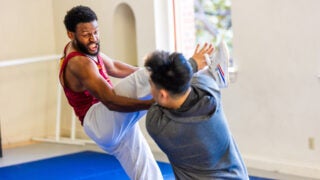‘Studio buddies’ help architecture students create digital camaraderie
There’s nothing like the collaborative magic of the architecture studio. That’s why the graduate student leaders at the USC School of Architecture found a way to recreate it online.
JP Luikart knows just how important the USC architecture studio can be.
Beyond being a place to work, it’s somewhere USC School of Architecture students go to hash out ideas and share an overall sense of camaraderie. It’s also a resource that was taken away when classes moved online.
Luikart, a graduate student, said remote learning has been a positive for interacting with faculty but a disconnect could definitely be felt between students.
“The thing we’ve noticed that we’re really lacking is that accidental collaboration,” he said.
That’s why the Graduate Architecture Student Association (GASA) started the “studio buddy” program: to help bridge any gaps among students and replicate the architecture studio online.
“It’s not that we’re missing a certain set of activities. We’re missing that environment, that space where anything can happen,” said Luikart, the president of GASA. “The accidental connections are the thing that everyone talks about missing.”
Bringing architecture students together requires more than just Zoom
With about 400 undergraduate and 300 graduate students in the USC School of Architecture, the studio buddy program’s goal is to pair first-year students with upperclassmen and continuing education students — those earning both graduate degrees and certificates. However, Luikart — along with fellow grad students Louise Rogier and Shadan “Shay” Mirzaei — said they wanted something more than just a weekly Zoom meeting.
We’re missing that environment, that space where anything can happen.
JP Luikart
“Having connections between the years is extra important, because that fell away,” Rogier said. “Now you’re behind a screen and only see your own studio group, instead of being able to look at other groups presenting from either previous years or years that you’re about to go into.”
The idea was conceived pre-COVID, but Rogier said the pandemic kicked the planning efforts into overdrive. The group wanted an interactive and creative environment that would best replicate the traditional studio, so they decided to use MMMURMUR, a website and app that allows users to work on various projects in an open online forum. It’s a new medium for the students, one Mirzaei described as a “space where people can see a floor plan, roam around and talk to each other in a more natural way than Zoom allows.”
“I think that it is more for the new students than it is for us,” Mirzaei added. “We know each other from previous years, and we can just text our friends or FaceTime them. For a new student, it’s probably really intimidating to reach out to a person and ask them a question, and I’m hoping that this kind of fixes that gap.”
Developing the online architecture studio program has taken most of the semester, so the first session using MMMURMUR was held a little more than a week before the winter break. Roughly 40 students RSVP’d heading into the first session, and Mirzaei said that the kickoff event went better than expected.
“MMMURMUR was much more comfortable than Zoom,” she said. “People were going around the room and just hanging out. Spirits were definitely up.”
Online studio environment emphasizes architecture students’ investment in USC culture, education
Zoom has indeed allowed for more direct — and perhaps even improved — conversations between instructors and students, said Alvin Huang, associate professor and director of graduate and post-professional architecture. But replicating the peer-to-peer interaction of the studio is not an easy task.
“The studio is the absolute physical heart of the architecture school, where students design, collaborate and socialize,” he said.
The studio is the absolute physical heart of the architecture school.
Alvin Huang
That’s why Huang was so glad to see that students were taking it upon themselves to recreate that setting. Though he acknowledged that the buddy system won’t replace the actual studio, he said it will definitely help extend that culture into a virtual realm.
“It’s great to see our students seizing the moment to ensure that the culture of our school can not only exist but also expand,” he said. “JP, Louise, Shay and the entire GASA leadership have been instrumental in establishing the culture that makes the USC School of Architecture so unique.”
The plan is to extend the program into next semester and hopefully have more events, now that they’ve found a successful format. All three students are cognizant of the fact that this isn’t a replacement for what they’re missing, but they’re hoping it can be a happy medium.
“I think the informality of it is really the most important piece,” Luikart said. “It sort of frees us up to have the creative conversations that drive the work we do.”



